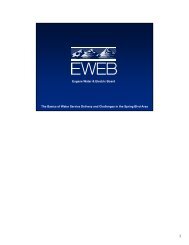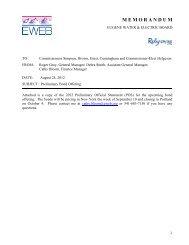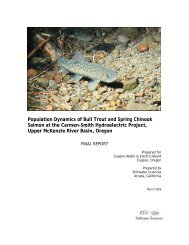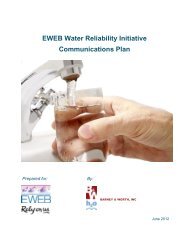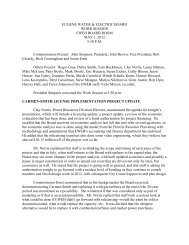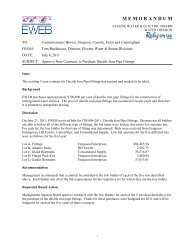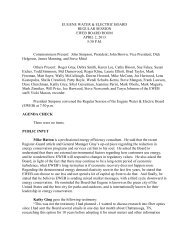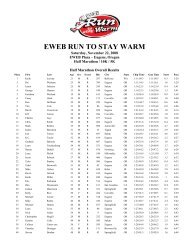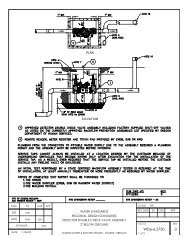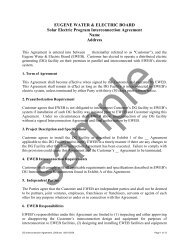Why and how EWEB trims trees - Eugene Water & Electric Board
Why and how EWEB trims trees - Eugene Water & Electric Board
Why and how EWEB trims trees - Eugene Water & Electric Board
- No tags were found...
You also want an ePaper? Increase the reach of your titles
YUMPU automatically turns print PDFs into web optimized ePapers that Google loves.
Trees <strong>and</strong> Power Lines<br />
WHY<br />
AND HOW<br />
<strong>EWEB</strong> TRIMS TREES
We are a city of <strong>trees</strong>.<br />
Trees are a source of beauty,<br />
shade our homes, reduce noise <strong>and</strong><br />
increase property values. We also are<br />
a society that depends on electricity to<br />
heat <strong>and</strong> light our homes, schools<br />
<strong>and</strong> offices.<br />
Sometimes, our love of <strong>trees</strong> <strong>and</strong><br />
our reliance on electricity conflict.<br />
Simply put, <strong>trees</strong> growing too close<br />
to overhead power lines must be<br />
pruned or removed because they can<br />
threaten your safety or cause power<br />
outages. The <strong>Eugene</strong> <strong>Water</strong> & <strong>Electric</strong><br />
<strong>Board</strong> has developed a tree-trimming<br />
program that is sensitive to the public’s<br />
desire for a lush urban tree canopy.<br />
We can have reliable power <strong>and</strong> still be<br />
known as a “City of Trees.”<br />
<strong>Why</strong> we prune <strong>trees</strong><br />
Like all other utilities, <strong>EWEB</strong> <strong>trims</strong> <strong>trees</strong><br />
to ensure the safe delivery of reliable<br />
power. We comply with Oregon Public<br />
Utility Commission <strong>and</strong> National <strong>Electric</strong><br />
Safety Code rules governing the amount of<br />
clearance needed around electrical wires <strong>and</strong><br />
other facilities. Trimming reduces outages<br />
during storms <strong>and</strong> lowers maintenance costs<br />
over time.<br />
We’re also concerned about your safety.<br />
<strong>Water</strong>, sap <strong>and</strong> chemicals in <strong>trees</strong> can be<br />
conductors of electricity. Branches that<br />
come into contact with electric wires can be<br />
dangerous, resulting in injury or death.<br />
How we trim <strong>trees</strong><br />
<strong>EWEB</strong> <strong>and</strong> most other utilities now use<br />
pruning techniques that meet the American<br />
National St<strong>and</strong>ards Institute (A300) st<strong>and</strong>ards<br />
<strong>and</strong> are recommended by the International<br />
Society of Arboriculture (<strong>and</strong> other<br />
organizations) as the correct form of trimming<br />
around higher-voltage power lines.<br />
These national st<strong>and</strong>ards <strong>and</strong> techniques<br />
utilize what are known as “natural directional<br />
pruning” methods. Basically, vertical<br />
tree stems <strong>and</strong> horizontal branches that<br />
conflict with wires are cut back to where<br />
the branches meet the trunk or to a larger<br />
“parent” branch that is not directed toward<br />
the wires. Here are a couple of examples:<br />
V-PRUNING<br />
V-pruning involves<br />
cutting back portions<br />
of a tree’s<br />
upper crown,<br />
creating space<br />
for overhead<br />
power lines.
SIDE<br />
PRUNING<br />
Side pruning<br />
consists of<br />
cutting back<br />
or removing<br />
side branches.<br />
Over time, these <strong>trees</strong> will be healthier, will<br />
live longer, <strong>and</strong> will require less frequent<br />
pruning, reducing maintenance costs.<br />
More examples can be found by visiting<br />
www.eweb.org (go to the “outages <strong>and</strong><br />
safety” section).<br />
Right tree, right place<br />
<strong>EWEB</strong> encourages homeowners <strong>and</strong><br />
l<strong>and</strong>scapers to plant the “right tree in the<br />
right place.” Plant only species near or<br />
under power lines that will never grow large<br />
enough to conflict with wires. Consult a<br />
tree specialist or visit www.eweb.org, for<br />
a list of acceptable species.<br />
Sometimes, replacement is the most<br />
logical choice. When appropriate, <strong>EWEB</strong><br />
will remove a tree <strong>and</strong> provide a voucher to<br />
purchase a new, more appropriate species<br />
for the location. <strong>EWEB</strong> does not remove<br />
<strong>trees</strong> without a property owner’s permission.<br />
Never attempt to remove or trim a tree that<br />
has power lines running through it. If you<br />
need tree trimming or removal assistance,<br />
please call <strong>EWEB</strong> Tree Trimming at<br />
541-685-7000, select “6” then “2”<br />
then “1.”
Proper selection <strong>and</strong> placement of <strong>trees</strong><br />
minimizes the need for utility pruning.<br />
TALL ZONE<br />
60 FT.<br />
15 FT. 15 FT.<br />
MEDIUM ZONE<br />
40 FT.<br />
LOW<br />
ZONE<br />
20 FT.<br />
OR LESS<br />
<strong>Eugene</strong> <strong>Water</strong> & <strong>Electric</strong> <strong>Board</strong><br />
500 East 4th Avenue<br />
<strong>Eugene</strong> OR 97401<br />
541-685-7000<br />
www.eweb.org<br />
April 2010




